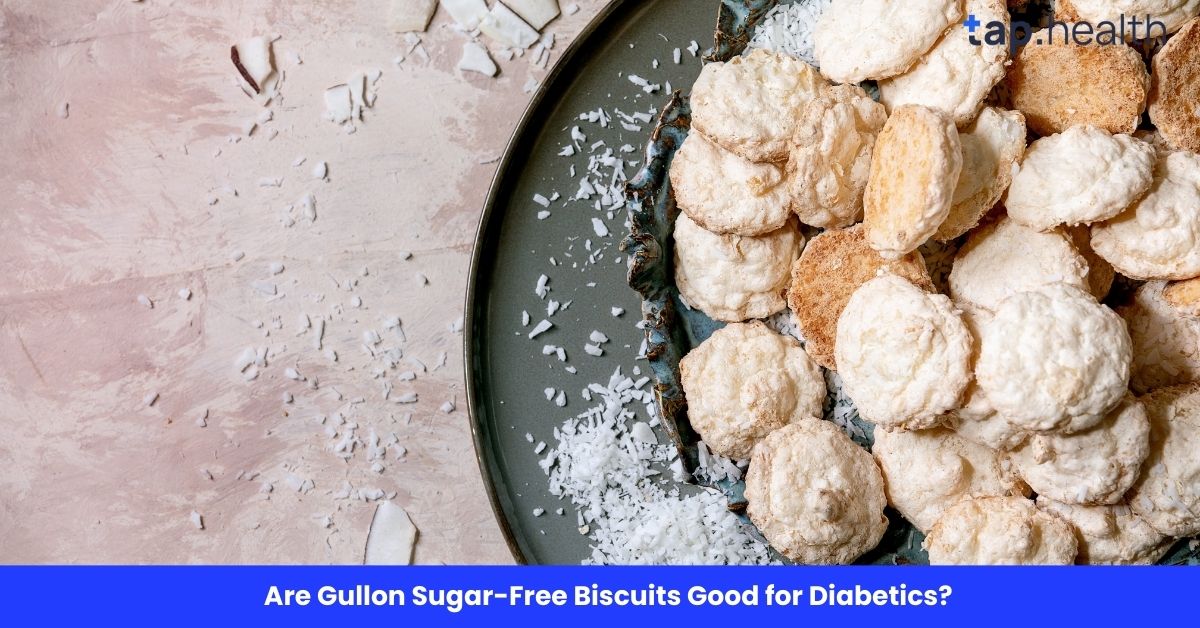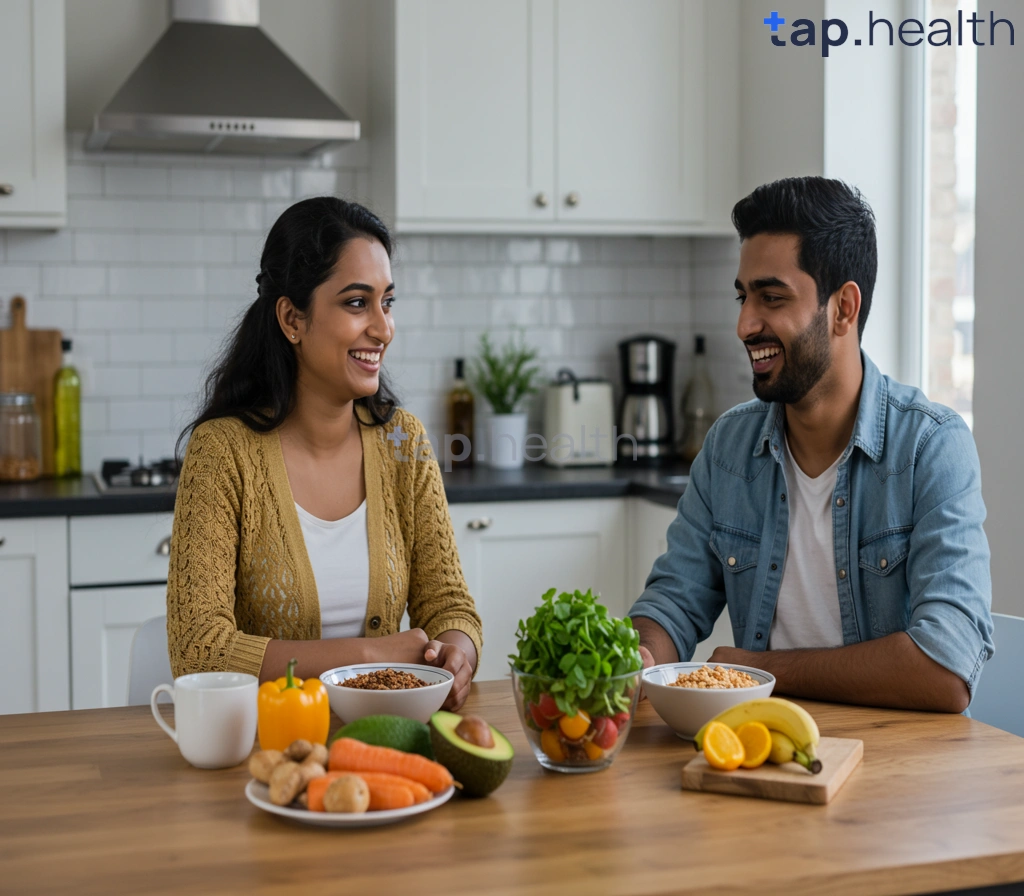If you’re managing diabetes, you know the daily struggle. You want something a little sweet, a little crunchy with your tea or coffee, but the guilt and worry about your blood sugar levels can ruin the moment. Then you see them on the shelf: Gullon Sugar-Free Biscuits. The packaging promises a delicious treat without the sugar. It sounds like the perfect solution.
But is it too good to be true? Are these popular biscuits truly a safe and healthy choice for people with diabetes?
The answer, like most things in nutrition, isn’t a simple yes or no. It’s a “yes, but…” and it’s crucial to understand what that “but” means.
Gullon sugar-free biscuits can be a better occasional option than regular, sugar-loaded biscuits, but they are not a “free pass” to eat as many as you want. They come with their own set of considerations that every person with diabetes needs to know.
This deep dive will explore everything you need to know about these biscuits. We’ll look under the hood at the ingredients, explain how they affect your body, and give you practical advice on how to enjoy them without worrying about your blood sugar levels.
What Are Gullon Sugar-Free Biscuits? A Quick Overview
Gullon is a well-known Spanish bakery company that has made a big name for itself in the “healthier” snack market. They offer a wide range of sugar-free products, from digestive biscuits and Maria cookies to waffers and chocolate-covered treats.
Their main selling point is right there in the name: sugar-free. They achieve this by replacing common sugars like sucrose or high-fructose corn syrup with alternative sweeteners and fibers.
But “sugar-free” doesn’t automatically mean “diabetes-friendly” or “carb-free.” To understand why, we need to become label-reading detectives.
Decoding the Ingredients: What’s Actually Inside?
Let’s take a close look at the ingredient list of a popular variant, like Gullon Sugar-Free Digestive Biscuits. You’ll typically find:
- Wheat Flour: This is still a refined carbohydrate. Your body will break it down into glucose, which raises blood sugar.
- Sweeteners: Maltitol and Cyclamate are common in these products. Maltitol is a sugar alcohol, and cyclamate is an artificial sweetener.
- Vegetable Oils (Palm, Sunflower): These provide fat, which can slow down the absorption of carbs, but palm oil is high in saturated fat, which isn’t great for heart health—a key concern for many with diabetes.
- Fiber: Inulin and Oligofructose. These are prebiotic fibers extracted from chicory root. This is one of the best ingredients in the mix, and we’ll explain why shortly.
- Raising Agents, Salt, Emulsifiers: These are for texture and taste and don’t significantly impact blood sugar.
- Contains a Source of Phenylalanine: A warning for people with the rare condition PKU, related to the artificial sweetener aspartame (used in some variants).
This list tells us the story. The sugar is gone, but it’s been replaced by other components that we need to understand.
The Sugar Alcohol Story: What is Maltitol?
This is the most critical ingredient to understand. Maltitol is a sugar alcohol (or polyol). It’s commonly used in “sugar-free” and “no sugar added” foods.
Here’s what you need to know about maltitol and diabetes:
How Maltitol Affects Blood Sugar
- Not Sugar-Free for Blood Sugar: Unlike some artificial sweeteners, maltitol is not calorie-free or carb-free. It contains about 2-3 calories per gram (compared to 4 calories per gram for sugar).
- It Has a Glycemic Index (GI): Regular sugar (sucrose) has a GI of 65. Maltitol has a lower GI, around 35. This means it raises blood sugar slower and lower than regular sugar, but it still raises it.
- The Carb Counting Problem: On nutrition labels in many countries, manufacturers can subtract the grams of sugar alcohols and fiber from the total carbohydrates to calculate “net carbs” or “impact carbs.” This is because they are not fully absorbed. However, maltitol is partially absorbed, and about half of it can impact your blood glucose. If you only look at “net carbs,” you might underestimate the real effect.
The Bottom Line: You cannot ignore maltitol. It will cause a blood sugar rise, especially if you eat more than one serving. It’s not as bad as sugar, but it’s not neutral.
The Fiber Factor: The Good Stuff (Inulin & Oligofructose)
This is the positive part of the Gullon story. Gullon often adds inulin and oligofructose, which are types of prebiotic soluble fiber.
Why is this a good thing?
- Slows Down Digestion: Fiber slows down the conversion of carbohydrates into glucose. This helps prevent a sharp, rapid spike in blood sugar levels.
- Promotes Gut Health: Prebiotics feed the good bacteria in your gut, which is linked to overall health and better blood sugar control.
- Adds Bulk: Fiber makes you feel fuller for longer, which can help with weight management—a crucial aspect of managing type 2 diabetes.
So, while the refined wheat flour and maltitol might push your blood sugar up, the fiber helps pull it back down by slowing the entire process. It’s a nutritional tug-of-war happening in your digestive system.
Nutritional Showdown: Gullon Sugar-Free vs. Regular Biscuit
Let’s look at the numbers for a typical digestive biscuit (per 100g for a fair comparison):
| Nutrient | Regular Digestive Biscuit | Gullon Sugar-Free Digestive | Why It Matters |
|---|---|---|---|
| Energy | ~500 kcal | ~450 kcal | Slightly fewer calories, but not a huge difference. |
| Total Carbohydrates | ~65g | ~75g | Wait, higher? Yes, but the type of carbs is different. |
| of which Sugars | ~15g | <0.5g | This is the big win. Almost no actual sugar. |
| Fat | ~22g | ~18g | Slightly less fat. |
| of which Saturates | ~10g | ~9g | Still contains palm oil, so saturated fat is still high. |
| Fiber | ~4g | ~25g | The massive difference. Huge fiber boost from inulin. |
What does this table tell us?
The Gullon biscuit wins on sugar content and fiber content. However, the total carbohydrate content is still high, and some of those carbs (from maltitol and flour) will affect your blood sugar. The fat content, particularly saturated fat, is still a concern.
So, Are They Good for Diabetics? The Final Verdict
Gullon sugar-free biscuits are a better occasional treat than regular biscuits for people with diabetes, but they are not a health food and should not be eaten freely.
Think of them as a “damage limitation” snack, not a “free” snack.
They are “good” in the sense that they will likely cause a lower and slower blood sugar spike compared to an equivalent regular biscuit, thanks to the lack of sugar and the high fiber content.
However, they are “not good” if you expect them to have zero effect on your blood glucose or if you use them as an excuse to overindulge.
How to Enjoy Gullon Biscuits Safely: The Golden Rules
If you decide to incorporate these biscuits into your diet, follow these rules to minimize any negative impact:
1. Portion Control is Non-Negotiable
This is the most important rule. Do not eat from the packet.
- Stick to the serving size on the label (usually 2-3 biscuits).
- Put your portion on a plate and put the packet away.
- Remember, even though they are sugar-free, the carbs and calories still add up.
2. Pair Them with Protein or Healthy Fat
Never eat carbohydrates by themselves. Pairing them with protein or fat slows down digestion even further, leading to a even more gradual release of glucose.
- Have your 2 biscuits with a handful of almonds or walnuts.
- Enjoy them with a small slice of cheese.
- Eat them after a meal that contained lean protein (like chicken or fish) and vegetables.
3. Time It Right
The best time for a higher-carb snack is after you’ve exercised or as part of a balanced meal. Your body is more sensitive to insulin at these times and better equipped to handle the carbohydrates.
4. Monitor Your Blood Sugar
This is the ultimate test. Everyone’s body is different.
- Check your blood sugar before eating.
- Check again 1-2 hours after eating 2 biscuits.
- See how your body responds. This data is more valuable than any general advice. If you see a significant spike, you’ll know to have just one next time or avoid them.
5. Watch Out for Digestive Side Effects
Sugar alcohols like maltitol are famous for causing gas, bloating, and a laxative effect, especially in large quantities. If you have a sensitive stomach, start with just one biscuit to see how you react.
Healthier Alternatives to Consider
While Gullon biscuits are an option, there are often better, whole-food choices that are more satisfying and nutritious:
- A Small Apple with a Tablespoon of Peanut Butter: Provides fiber, natural sweetness, protein, and healthy fats.
- A Handful of Berries with Plain Greek Yogurt: Berries are low-GI fruits, and yogurt is packed with protein.
- A Few Whole-Grain Crackers with Cheese: Offers a crunchy, savory alternative.
- A Handful of Nuts and Seeds: A great source of healthy fats, protein, and fiber with minimal impact on blood sugar.
- Homemade Oat Cookies: Make your own using almond flour, oats, a mashed banana for sweetness, and nuts.
The Big Picture: It’s About Your Overall Diet
One Gullon sugar-free biscuit is not going to make or break your diabetes management. What matters is your overall dietary pattern.
Focus on building your meals around:
- Non-starchy vegetables (spinach, broccoli, peppers)
- Lean proteins (chicken, fish, tofu, legumes)
- Healthy fats (avocado, olive oil, nuts)
- High-fiber, complex carbs (berries, quinoa, sweet potato, lentils)
When your diet is primarily made of these nutrient-dense foods, the occasional sugar-free biscuit as a treat has a much smaller impact on your overall blood sugar control (HbA1c levels).
Real-Life Scenario: A Day with Gullon Biscuits
Let’s make this practical. Imagine two different people, both with type 2 diabetes, decide to have Gullon sugar-free biscuits as an afternoon snack.
Scenario 1: Maria’s Mindful Approach
- 2:30 PM: Maria feels a bit peckish. She just had a balanced lunch of grilled chicken and salad two hours ago.
- Her Action: She takes two Gullon Digestive biscuits, puts them on a plate, and immediately puts the packet back in the cupboard. She then eats them slowly with a cup of tea, enjoying each bite.
- The Pairing: She has a small handful of almonds (about 6-7) alongside her biscuits.
- The Outcome: The protein and healthy fats from the almonds, combined with the high fiber in the biscuits and the fact she recently ate a meal, significantly slow down the digestion of the carbohydrates. Her blood sugar experiences only a very mild, manageable rise.
Scenario 2: John’s Unplanned Indulgence
- 11:00 AM: John is hungry, and lunch is still an hour away. He grabs the packet of Gullon sugar-free waffers from the cupboard.
- His Action: He sits in front of the TV and starts eating directly from the packet. Because they taste sweet and “safe,” he loses track and ends up eating six waffers.
- The Pairing: He drinks a black coffee with them—no protein or fat in sight.
- The Outcome: The large dose of refined flour and maltitol hits his empty stomach all at once. Despite being “sugar-free,” the sheer volume of carbs causes a significant blood sugar spike. An hour later, he might also experience bloating and stomach discomfort from the high dose of sugar alcohols.
The Lesson: The biscuit itself is just one variable. How you consume it—the portion size, the timing, and what you pair it with—is what truly determines its impact on your health.
Expert Contribution: What Do Dietitians Say?
We should never rely solely on internet articles for medical advice. So, what is the professional consensus on products like these?
Registered Dietitians and Certified Diabetes Care and Education Specialists (CDCES) generally agree on the following points:
- They Are a Transition Tool, Not a Solution: Many experts see value in these products for people who are newly diagnosed and struggling to give up their favorite snacks. They can be a helpful stepping stone while learning to adopt a healthier overall diet.
- The Focus Should Be on Whole Foods: The consistent message from nutrition professionals is to prioritize whole, unprocessed foods. An apple with peanut butter will always be a nutritionally superior choice to a processed sugar-free biscuit.
- Beware of the “Halo Effect”: Experts warn about the psychological “health halo” of labels like “sugar-free” and “diabetic-friendly.” These labels can trick us into thinking a product is healthy, leading to overconsumption. A dietitian would encourage you to look past the marketing and read the actual ingredient list.
- Individual Response is Key: A common piece of advice from experts is to use a glucose meter to become your own detective. Your body’s response is the most important data point. If a food causes a spike, it’s not a good choice for you, regardless of what the packaging claims.
In summary, experts don’t demonize products like Gullon biscuits, but they don’t enthusiastically recommend them either. They are placed in the category of “processed treats” to be used with caution and awareness, not as a staple of a diabetic diet.
Recommendations Grounded in Proven Research and Facts
Making decisions based on evidence is crucial for managing diabetes. Here are the key research-backed facts that should guide your choice:
- Sugar Alcohols Impact Blood Glucose: Numerous studies, including those published in the American Journal of Clinical Nutrition, confirm that sugar alcohols like maltitol have a measurable glycemic impact. They are not inert. Their Glycemic Index (35 for maltitol) is lower than sugar (65) but is not zero. Fact: They will raise your blood sugar.
- Fiber is a Powerful Moderator: The addition of inulin and oligofructose is a positive feature supported by science. Research shows that soluble fiber can slow gastric emptying and the absorption of glucose, leading to improved post-meal blood sugar levels. This is why the high fiber content in Gullon biscuits is their biggest nutritional advantage.
- The Total Dietary Pattern is What Matters Most: Large-scale studies, such as the Diabetes Prevention Program (DPP), have proven that the overall quality of your diet is the strongest predictor of long-term success. Focusing on whether one specific processed food is “good” or “bad” misses the forest for the trees. Fact: A diet rich in vegetables, lean proteins, and whole grains is the proven path to better blood sugar control.
- Saturated Fat Intake Should Be Monitored: Guidelines from the American Diabetes Association emphasize the importance of heart health for people with diabetes, as they are at an increased risk for cardiovascular disease. The palm oil in these biscuits contributes saturated fat. Fact: Limiting saturated fat is a key dietary recommendation.
Final Evidence-Based Recommendation: Based on these facts, Gullon sugar-free biscuits can be considered an occasional processed snack option that is likely to have a lower glycemic response than a conventional biscuit. However, they should not be considered a health food and must be consumed in strict moderation within a balanced diet focused on whole foods.
For a deeper dive into comparing specific biscuit types and brands, you can explore our detailed guide on which biscuits are good for diabetes.
Conclusion: The Balanced Verdict
So, are Gullon sugar-free biscuits good for diabetics? The balanced answer is that they are a tool, not a miracle.
They are a better choice than regular biscuits for satisfying a occasional crunch and sweetness craving without causing a massive sugar spike, thanks to their lack of sugar and high fiber content.
However, they are not a health food. They are still a processed product containing refined carbohydrates, sugar alcohols that can affect blood sugar and digestion, and saturated fats.
The green light to eat them comes with strict conditions: tiny portions, careful pairing with protein or fat, and mindful consumption as a rare treat, not a daily ritual.
Your best bet is to build a diet so rich in nutritious, whole foods that processed snacks like these become an afterthought. But when the craving hits, you now have the knowledge to navigate the choice smartly and safely.
FAQ: Your Gullon Sugar-Free Biscuit Questions Answered
Q1: Will Gullon sugar-free biscuits raise my blood sugar?
A: Yes, most likely, but probably less than a regular biscuit. The refined wheat flour and the sugar alcohol (maltitol) contain carbohydrates that your body can convert to glucose. The high fiber content helps slow this process down, preventing a major spike. The only way to know for sure is to test your blood sugar after eating them.
Q2: What are the side effects of eating these biscuits?
A: The most common side effect is digestive upset. Sugar alcohols like maltitol can cause gas, bloating, cramping, and diarrhea, especially if you consume more than the recommended serving size. They have a well-known laxative effect.
Q3: Can I eat Gullon biscuits every day?
A: It’s not recommended. While they are a better option, they are still a processed food containing refined flour, artificial sweeteners, and saturated fats. They should be treated as an occasional treat, not a daily health food. Relying on them daily could take the place of more nutritious snacks like fruits, nuts, or yogurt.
Q4: Are there better sugar-free biscuit brands for diabetics?
A: “Better” is subjective and depends on the ingredients. Look for brands that:
- Use almond flour or coconut flour instead of wheat flour for a lower carb count.
- Use stevia or erythritol as sweeteners instead of maltitol, as these have virtually no impact on blood sugar and fewer digestive issues.
- Have even higher fiber and lower saturated fat content.
Q5: Do I need to count the carbs in Gullon biscuits?
A: Yes, absolutely. Do not ignore the total carbohydrate count. While the “net carb” calculation (total carbs minus fiber and sugar alcohols) can be useful, remember that maltitol is partially absorbed. A safe approach is to count about half of the maltitol carbs. If you use insulin, discuss with your doctor or dietitian how to best bolus for these products.
Q6: The package says “Diabetic Food.” Is it safe to trust this label?
A: Be cautious. Terms like “diabetic food” are often marketing slogans. There is no legal definition for what this means. These products are not necessary for a diabetic diet, which should be based on whole, nutritious foods. Always read the nutrition facts and ingredient list yourself to make an informed choice.



